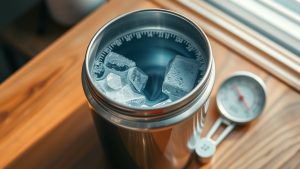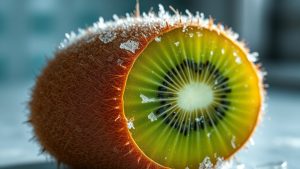
Water usually takes about 1 to 2 hours to freeze in a standard household freezer, but several factors can affect this time. The temperature of the water and the surrounding environment plays a vital role, as does the container's size and material. Smaller volumes freeze faster, and agitation can enhance the process. If you want to understand the details behind these influences, there's more to explore on this topic.
When you think about how long it takes for water to freeze, several factors come into play that can greatly influence the freezing time. The most important of these factors is the temperature of the surroundings. If the environment is colder, water freezes faster; conversely, a warmer setting prolongs the freezing process. The initial temperature of the water also matters. Generally, colder water freezes quicker than warmer water, but there are exceptions due to various thermodynamic principles at work.
The amount of water you're dealing with plays a vital role too. Smaller volumes freeze faster since they require less heat to be removed. For instance, a small ice cube tray will yield frozen cubes more quickly than a large bowl of water. The container's material and its thickness further complicate the freezing time. Metal containers, for example, conduct heat more efficiently than plastic ones, meaning they can facilitate faster heat loss and, consequently, quicker freezing.
The volume and material of the container significantly influence how quickly water freezes, with smaller, metal containers promoting faster freezing.
Environmental conditions, such as humidity and air movement, can also affect freezing times. Lower humidity levels and increased air movement help promote faster heat loss. If you're outdoors, weather conditions like wind or direct sunlight can greatly influence how quickly water freezes. The presence of insulation, whether from the container or the surrounding environment, can alter heat loss rates as well. For example, a well-insulated container can slow down the freezing process by retaining heat.
Freezer settings are another key factor. A freezer set to a lower temperature will freeze water faster than one set at a higher temperature. Geographical location also plays a role; in colder climates, outdoor water may freeze more quickly than in warmer regions. The size and thickness of the container, along with its shape and surface area, affect heat transfer rates, impacting freezing time. A shallow, wide container will generally freeze water faster than a tall, narrow one due to a larger surface area for heat exchange.
Agitation of the water can also speed up the freezing process. By stirring, you distribute heat more evenly, which helps promote faster freezing. Understanding the freezing point is essential too. Pure water freezes at 0°C (32°F), but dissolved substances can lower this point, affecting how quickly freezing occurs. The principles of thermodynamics dictate that heat must be removed from the water for it to freeze, and thermal diffusion determines how quickly heat moves through it. Additionally, the amount of water influences freezing duration, as less water freezes faster.
In experimental conditions, controlling variables is vital to accurately study freezing times. The temperature of the water serves as a key independent variable, while the time taken to freeze is the dependent variable. Keeping conditions constant, such as the temperature of the freezer and the size of the container, enables reliable comparisons.
Designing experiments properly guarantees that results are both reliable and reproducible, allowing for a deeper understanding of how various factors interact in the freezing process.
Conclusion
In summary, the time it takes for water to freeze varies depending on factors like temperature, volume, and container type. Generally, a standard tray of water can freeze in about 2 to 4 hours when placed in a freezer set to 0°F. Imagine a medieval alchemist, waiting for their potion to solidify—a process that mirrors your own anticipation as you check the freezer. Understanding these variables allows you to optimize freezing times for your needs, ensuring perfect ice every time.



